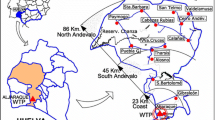Abstract
During rain storm events, land surface runoff and resuspension of bottom sediments cause an increase in Trihalomethane (THM) precursors in rivers. These precursors, when chlorinated at water treatment facilities will lead to the formation of THMs and hence impact drinking water resources. In order to evaluate the wet weather impact on the potential formation of THMs, river samples were collected before, during and after three rain storms ranging from 15.2 to 24.9 mm precipitation. The samples were tested for THM formation potential and other indicators including UV254 absorbance, turbidity and volatile suspended solid (VSS). Average levels of THMs increased from 61 μg/l during dry weather to 131 μg/l during wet weather, and then went back to 81 μg/l after rain ended. Wet weather values of THM are well above the maximum contaminant level (MCL) 80 μg/l, set by EPA for drinking water. THM indicators also exhibited similar trends. Average levels increased from 0.6 to 1.8 abs; 2.6 to 6 ntu; and 7.5 to 15 mg/l respectively for UV254, turbidity and VSS. A positive correlation was observed between THM formation and THM indicators. The t-test of significance (p-value) was less than 0.05 for all indicators, and R values ranged from 0.85 to 0.92 between THMs and the indicators, and 0.72 to 0.9 among indicators themselves.
Similar content being viewed by others
References
Alkhatib, E., & Castor, K. (2000). Parameters influencing sediment resuspension and link to sorption of inorganic compounds. Environmental Monitoring Assessment, 65, 531–346.
APHA–AWWA–WEF (1995). Standard methods for the examination of water and wastewater. 19th ed. American Public Health Association, American Water Works Association, and Water Environment Federation. American Public Health Association, Washington, DC.
Aquarion Hydraulic (2005). Water quality and environmental management standard operating procedure. Bridgeport, CT.
El-Dib, M., & Ali, R. (1995). THMs formation during chlorination of raw Nile river water. Water Research, 29, 375–378.
Espigares, M., Lardelli, P., & Ortega, P. (2003). Evaluating Trihalomethane content in drinking water on the basis of common monitoring parameter-regression models. Journal of Environmental Health, 66.3, 9(5)
Golfinopoulos, S. (1998). Use of a multiple regression model for predicting Trihalomethane formation. Water Research, 32, 2821–2829.
Hutton, P. (1992). Simulating THM formation potential in Sacramento Delta: Part 1. Journal of Water Resources and Planning and Management, 5, 513–529.
Ivancev, T., Dalmacija, B., & Klasnja, M. (2004). Formation of by-products in the course of intermediate ozonation of ground water pretreated with ozone and polyaluminium chloride. Water Science and Technology, 49(4), 63–68.
Jack, J., Sellers, T., & Bukaveckas, P. (2002). Algal senescence impact on THMs formation. Canadian Journal of Fisheries and Aquatic Sciences, 59(9), 1482–1491.
Liang, L., & Singer, P. (2003). Factors influencing the formation and relative distribution of haloacetic acids and trihalomethanes in drinking water. Environmental Science and Technology, 37(13), 2920–2928.
Morrow, C., & Minear, R. (1987). Use of regression models to link raw water characteristics to trihalomethane concentrations in drinking water. Water Research, 21, 41–48.
Page, D. W., van Leeuwen, J. A., Spark, K. M., Drikas, M., Withers, N., & Mulcahy, D. E. (2002). Effect of alum treatment on the trihalomethane formation and bacterial regrowth potential of natural and synthetic waters. Water Research, 36(19), 4884–4892.
Pavelic, P., Nicholson, B. C., Dillon, P. J., & Barry, K. E. (2005). Fate of disinfection by-product in ground water during aquifer storage and recovery with reclaimed water. Journal of Contaminant Hydrology, 77(1–2), 119–141.
Rook, J. J. (1976). Haloforms in drinking water. Journal of the American Water Works Association, 68, 168–172.
Serodes, J., Rodrriguez, M., Li, H., & Bouchard, C. (2003). Occurrences of THMs and HAAs in experimental chlorinated waters of Quebec City area. Chemosphere, 51(4), 253–263.
Urano, K., & Takemasa, T. (1986). Formation equation of halogenated organic compounds when water is chlorinated. Water Research, 20, 1555–1560.
Author information
Authors and Affiliations
Corresponding author
Rights and permissions
About this article
Cite this article
Alkhatib, E., Peters, R. Wet weather impact on trihalomethane formation potential in tributaries to drinking water reservoirs. Environ Monit Assess 139, 173–181 (2008). https://doi.org/10.1007/s10661-007-9823-y
Received:
Accepted:
Published:
Issue Date:
DOI: https://doi.org/10.1007/s10661-007-9823-y




